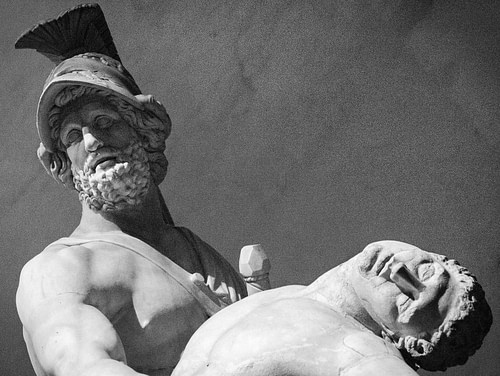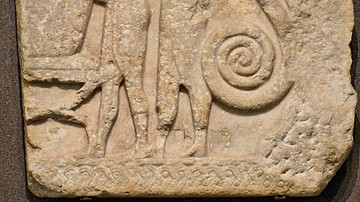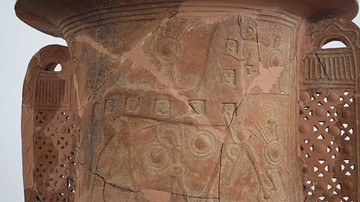
Menelaus (also Menelaos) is a figure from ancient Greek mythology and literature who was the king of Sparta and the husband of beautiful Helen, whose abduction by the Trojan prince Paris sparked off the legendary Trojan War. The story is most famously told in Homer's Iliad where Menelaus persuades his brother Agamemnon, king of Mycenae, to form a great army from all the Greek city-states and sail to Troy to recapture Helen. During the war, Menelaus and Paris confront each other in a one-on-one fight. The Spartan king overwhelms Paris but the prince is saved by the goddess Aphrodite who whisks him from the scene in a magical cloud. The Greeks win the war and in Homer's Odyssey, we are told of Menelaus' journey home with Helen, stopping on the way at Crete, Cyprus, and Egypt.
Family
In Greek mythology, Menelaus was the son of Atreus, the king of Mycenae and the younger brother of Agamemnon. In some traditions, the two brothers were the grandchildren of Atreus but were looked after by him when his son and their father Pleisthenes died prematurely. Their mother was Aerope, the daughter of Catreus, the king of Crete. The family union between Greece and Crete perhaps reflected a desire on the part of the Bronze Age Mycenaean Greeks to claim some sort of cultural heritage from the earlier Minoan civilization on that island.
As children, Menelaus and Agamemnon were forced to flee the family home following the dispute between Atreus and his brother Thyestes which ended in the murder of the latter's children. This squabble led to a curse on the house of Atreus and his descendants. Thyestes' other son Aegisthus (born out of an incestuous relationship with Thyestes' daughter Pelopia) then gained revenge by killing his uncle Atreus and obliging Agamemnon and Menelaus to seek refuge with Tyndareus, the king of Sparta.
Tyndareus was a perfect host and adopted the two boys. The Spartan king even arranged for Agamemnon to marry his daughter Clytemnestra while Menelaus married his other daughter Helen. Tyndareus made all the Greek leaders swear to recognise Helen as Menelaus' rightful wife and to protect his daughter from harm. Agamemnon and Menelaus then returned to Mycenae to deal with Thyestes and Aegisthus. Agamemnon thus became the king of Mycenae while Menelaus became Tyndareus' heir. Consequently, Menelaus eventually became the king of Sparta in most sources of the myth but Aeschylus (c. 525 - c. 456 BCE), the writer of Greek tragedy, does have him living in Argos. Menelaus and Helen had one daughter, Hermione. The curse on the house of Atreus was not quite finished, though, and so the Trojan War began.
The Trojan War
Menelaus appears as one of the heroes of the Trojan War story told in Greek literature, oral legends, and all forms of art from sculpture to pottery. In legend, Menelaus is wealthy and hospitable but he is also one of the main reasons the war happened in the first place. True, he was the victim when his wife Helen, said to be the most beautiful woman in Greece, was abducted by the Trojan prince Paris and whisked off to Troy. Paris, who was visiting Sparta on a friendly diplomatic visit, had claimed Helen as a prize from Aphrodite after he had selected the goddess in a beauty contest with her fellow goddesses Hera and Athena, held at the wedding of Peleus and Thetis. Eager to get his wife back, Menelaus appealed to his brother Agamemnon, by now king of Mycenae and the most powerful ruler in the Greek world. Agamemnon, eager for war, booty and revenge, reminded the Greek leaders of their oath to protect Helen and galvanised such Greek city-states as Athens, Corinth, Rhodes, and Argos into action. The massive army set sail for Troy in a mighty fleet of ships.
The Greeks themselves considered the Trojan War to have occurred in the 13th century BCE. This date is actually confirmed by excavations at the site of Troy (aka Ilium) in Turkey, especially the layer known as Troy VI (c. 1750-1300 BCE), which shows the city then had great walls and towers. Further, there is evidence of a conflict in the form of fire destruction and bronze arrowheads embedded into the walls. The Mycenaean civilization of Greece and the Hittites of Anatolia likely frequently clashed over control of trade routes and attempts at colonization in the region, although it is highly unlikely such a decade-long war as the Trojan War ever took place.
The real-life conflicts in the eastern Mediterranean, then, likely inspired the legend of the Trojan War, told most famously in Homer's Iliad. This epic poem was written sometime in the 8th century BCE, and it covers only the last 52 days of the 10-year Trojan War. Amongst the fighting men were such heroes as Achilles, Odysseus, and Ajax. On the Trojan's side were great warriors like Hector, brother of Paris. Even the gods got involved in the greatest war yet seen with Athena, Poseidon, and Hephaistos amongst those supporting the Greeks. The Trojans could call on the support and occasional intervention of such gods as Apollo, Aphrodite, and Ares.
Menelaus vs. Paris
When Menelaus and Agamemnon arrived with their armies, the first and most disappointing sight was the mighty walls of the city of Troy. These great defences resulted in the conflict becoming one of siege warfare interspersed with some action on the plain in front of the city when the Trojans risked a sortie or two. In the Iliad, Menelaus is portrayed as a courageous fighter and man of honour but he is not quite put in the top rank of warriors. He is seen as being a bit too lenient, as for example in the episode when he seeks to spare the life of Adrestus but Agamemnon disagrees and the Trojan is killed.
One of the highlight battles was that between Menelaus and Paris in single combat (Book 3 of the Iliad), called by the Spartan king to settle the war there and then and decide who would keep Helen. Menelaus, referred to by Homer as 'master of the war-cry,' faces Paris, wearing slightly flashy and inappropriate armour, while Helen looks on from the walls of Troy. The two warriors draw lots to see who will have first throw with their spear. Paris wins and throws first but his spear lands harmlessly into the shield of Menelaus. The Greek king then throws his weapon with tremendous force and the spear shoots right through the shield of Paris and carries on through to pierce his armour. Fortunately for Paris, he sways at the last moment and avoids certain death. However, Menelaus is not finished and with his sword he strikes a fearful blow on the Trojan prince's helmet. The sword shatters and falls in pieces into the dust. Menelaus then grabs Paris' helmet with his bare hands and proceeds to drag him from the field of combat. Choking as his helmet strap is wrapped around his neck, Paris is only saved through the intervention of Aphrodite who breaks the strap and, covering the prince in a thick mist, spirits her favourite back to the safety of his perfumed bedroom.
Menelaus next crops up in the battle when Hector, 'tamer of horses,' son of king Priam and the greatest Trojan warrior, challenges any Greek to combat. Menelaus is keen to accept, but Agamemnon persuades him not to. Instead, Ajax, having drawn lots for the honour, marches out to meet the prince. The pair clash but without a decisive blow, and Ajax proves the master. Darkness then calls a halt to the fight, and they part on peaceful terms. Menelaus does get to fight Hector later when the pair squabble over the body of the fallen Euphorbos.
Reunited with Helen
The war then rumbles on with Achilles finally getting into the action and killing Hector in a duel to the death. The Iliad ends there but the story continues in such sources as the Epic Cycle (7th-6th century BCE) with Achilles being struck and killed by an arrow to his heel, fired by Paris. Philoctetes, the famed archer, gained revenge for Achilles by fatally shooting Paris with the legendary bow of Hercules. The Greeks finally managed to get inside Troy by building a huge wooden horse which the Trojans think is left as a gift from their seemingly departed enemy. In reality, the horse is full of Greek warriors - including Menelaus - and they open the gates of the city to their followers, and a general rout of Troy follows. The Greeks had won the war. Menelaus and Helen are reunited but, according to some versions of the story, the Spartan king first draws his sword and intends to strike down his wife before having a rethink and embracing her. This scene, with Menelaus holding a sword and standing by Helen, is sometimes seen on painted Greek pottery; there is even one example where he has dropped his sword clearly indicating a change of heart. The reconciled pair then return home - eventually.
The Odyssey Home
In book four of Homer's Odyssey, also written in the 8th century BCE, Menelaus meets Telemachus, the son of Odysseus, after the Trojan War. Telemachus arrives at Sparta searching for his lost father, not seen since the end of the war. The king, once more playing his part of host well, gives a dinner. Menelaus does not know the fate of Odysseus but he recounts the episode of the great Wooden Horse which the Greeks used to enter the city of Troy and win the war. Menelaus then recounts his own mini-Odyssey after leaving Troy which is perhaps a mythologising of the real-life actions of Mycenaean pirates and colonists in the late Bronze Age Mediterranean.
First, Menelaus lands on Crete after his ships are dashed against the rocky shores because of a storm. Next arriving in Egypt, the king spends many years there. Unable to gain favourable winds to get home, Menelaus makes trips to Cyprus and then the city of Sidon in Phoenicia, land of fine textiles and silverware, some of which the Spartan receives as souvenirs. Next is North Africa (Libya) which he describes as a bountiful land with sheep which give birth three times a year and where there is never a shortage of milk, cheese or meat. Ethiopia is also visited during this time, and the king's treasure trove grows.
Finally, Menelaus meets with the sea god Proteus, aka the 'Old Man of the Sea', who lives near Pharos. Menelaus was keen to ask Proteus questions such as how to catch a breeze that will take him home to Greece. Unfortunately, the god kept changing shape to elude the Spartan king. Menelaus and his men thus disguise themselves as seals and mix with Proteus' flock of that animal. The Spartans then leap out and grab Proteus but the sea god transforms himself into many different creatures to elude capture, first a lion, then a snake, panther, and boar. Still captive, Proteus transforms himself into water and finally a tree.
Proteus gives up his act and eventually tells Menelaus he must perform a great sacrifice to the gods in Egypt to gain those favourable winds. He is also informed that Odysseus is being held in the clutches of the Nymph Calypso on her remote island. Back at the Spartan dinner, Telemachus thanks his host and then goes on his way to continue the search for his father.
Proteus had predicted that Menelaus would not die but one day arrive at Elysium, the Greek version of paradise which is located at the ends of the earth and reserved only for the virtuous and worthy. Before he achieves this land of peace, Menelaus does perform the necessary sacrifices and finally get back home to Sparta. Orestes the son of Agamemnon then marries Hermione, Menelaus' daughter and so the two cities of Mycenae and Sparta were united under a single king. When Menelaus left this earth, he was succeeded as king of Sparta by Orestes.

Herodotus' Histories
Menelaus is mentioned in the c. 415 BCE Histories of Herodotus (c. 484 - 425/413 BCE). In Book 2:118-119 of this work, the Greek historian describes a slightly different story from Homer which he claims to have heard first-hand from Egyptian priests. Paris (called Alexandros by Herodotus) does abduct Helen but the ship carrying the fugitive pair is blown off course and lands in Egypt, never making it to Troy. The Egyptian king Proteus (not a sea god for Herodotus), then holds them in custody until Menelaus arrives. The Greek army does anyway lay siege to the city of Troy despite the Trojans insisting that Helen is not there but in Egypt. When Troy falls and Helen is not found, Menelaus then sails to Egypt to see if the Trojans had been telling the truth all along. Arriving at Memphis, Helen is reunited with her husband. Menelaus is keen to get home but unreasonable weather keeps his ships in port. To change the weather, and appease the gods, the Spartan king sacrifices two Egyptian children, shocking his hosts who then pursue Menelaus to Libya but eventually lose him.
Other Works, Art & Cult
Menelaus appears in the 415 BCE play Trojan Women by Euripides (c. 484-407 BCE) where he has a much weaker character than in Homer's work. In the play, Helen defends herself in a trial and blames the gods for intervening in human affairs. Menelaus comes across as a simple man merely keen to have his beautiful wife back. The king appears as an even more disagreeable character in Euripides' Andromache (c. 425 BCE) and Orestes (c. 408 BCE), as well as the tragedy Ajax by Sophocles (c. 496 - c. 406 BCE).
In the visual arts, Menelaus appears in the north metopes of the Parthenon (447-432 BCE) with various other scenes from the Trojan War. The Spartan king alongside Helen (typically in confrontation) or leading her away or in the act of reconciliation, and the duel with Paris were popular themes for both red- and black-figure pottery painters.
Finally, at Therapne near Sparta, the king was part of a cult along with Helen with whom he was believed to share a tomb. The tomb was built c. 700 BCE near a 15th-century BCE Mycenaean 'palace' and consisted of a large rectangle of ashlar blocks with a small temple, all set on a mound and approached by a ramp. Excavations have revealed the site received dedicatory offerings to the pair and was in use until the 1st century BCE.








